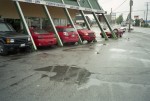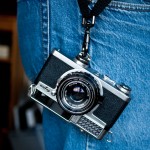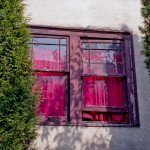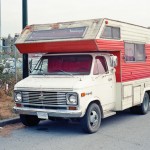Jul
11
2014

Yes that’s right this little 110 film camera is actually a rangefinder with a slider on top that adjusts to bring the two images in the viewfinder together and in focus. I had this already out of date film in the camera for several years treating each frame like it was some sort of precious commodity never to be seen again, which it pretty much is. The camera itself probably occupies more volume than a 35mm Olympus Stylus Epic and is very heavy so you really need to want to take pictures on a tiny little chip of film to justify using it. There is no denying that it makes distinctive looking images. I suppose you could argue that the look might be nearly achieved with processing but where is the fun in that? That’s also why I’ve left the area around the image in the scans why hide the origin of the images it’s part of their appeal.
I didn’t want to cut the film yet until I figure out the details of a holder for it for my scanner so I made this little ad hoc scanning set up with pieces of black paper to hold it against its natural propensity to curl into a ball like a digital photographer that forgot to charge their battery.

no comments | tags: 110, film, rangefinder | posted in Cameras, Photography, Processing
Jun
27
2014





The Fujica 35SE is as beautiful as the pictures it can take. I say ‘can take’ just in case you don’t like my pictures although why I can’t imagine. Doesn’t everyone want pictures of random stuff that catches my eye?
I have had this camera for about 5 years now and it hasn’t disappointed me in any way. I would use it even more often if I didn’t have so many other cameras to play with and post about. Another post about this camera with some images that I am pleased with can be seen here Fujica 35SE Rangefinder Respect. I strongly recommend this camera though it isn’t all that common. When you can find one it does sell pretty inexpensively compared to ‘it can take’ results.
1 comment | tags: camera, Fujica, rangefinder | posted in Cameras, Photography
Oct
26
2013

One of the smallest rangefinders you can find, the Olympus XA is a great little carry anywhere camera. The only drawback is the tiny little focus control and it’s semi hidden nature makes focusing somewhat fussy. You can set the aperture and focus in such a way that it works as zone focusing. At f5.6 and focused at xyz everything from x feet to infinity is rendered clearly enough for most uses.
no comments | tags: film, olympus, rangefinder | posted in Photography
Apr
30
2013

I love when cameras exceed my expectations. You might, like me, think that a camera from 1960 with a programmed shutter and aperture would be questionable, not in this case though. The Minolta Uniomat has a selenium meter just bellow the shutter button that moves a galvanometer on the top plate. If you adjust the exposure ring around the lens it moves an arm also in the window with the galvanometer needle, when the arm and the needle match that is the suggested setting for the scene. When adjusting the camera like this you actually have no independent control over the shutter and aperture it follows a set program line. I’ve created this handy little chart which does actually give an indication of the aperture and shutter speed for any EV setting.

You can see in the pictures where I allowed direct sunlight to reach the lens that the images are quite washed out, I think quite a bit of this came from the original uncoated Minolta filter that I left on for the testing.
5 comments | tags: camera, film, Minolta, rangefinder | posted in Cameras, Photography
Oct
31
2012
There are several reasons that the Fujica 35SE is a favorite of mine. The primary one is how you focus. As it is a rangefinder you determine focus using a focus patch in the center of the viewfinder as you would expect but the focus movement is done via a thumb-wheel on the back. This is both quicker and easier than using the left hand around the lens as is more common. and has the added benefit of freeing the left hand to just steady the camera in a comfortable grip, this can not be overstated.

The other is the results from the 45mm 1:2.8 lens. Other things that make this camera different are the film advance lever location on the bottom and the exposure system where a change in shutter speed changes the aperture correspondingly. There are other little touches that help to add up to make it more than the sum of those parts.
I used the camera attached to a long sliding strap where I allowed the camera to just hang upside down. This is actually the perfect camera to use like this because you can advance the film with one hand and then bring the camera up and focus with the same hand.

While I was out shooting on this day I had a Sony CS1 GPS attached to my camera bag tracking my movements. There is a mix of my walking and some of my driving including when I forgot that it was still on and drove over the Cambie Street Bridge.
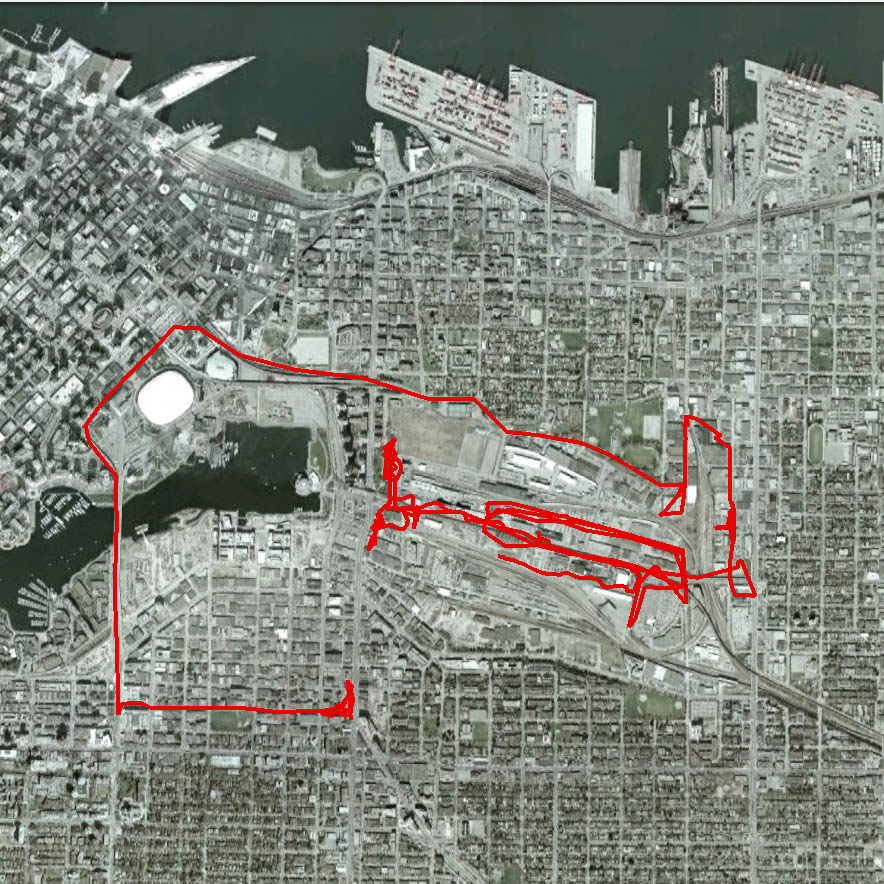

9 comments | tags: camera, film, Fujica, rangefinder | posted in Cameras, Photography
Jan
16
2012
Not to be confused with shooting a Red Rider BB gun. When you use a lot of older rangefinder cameras they do seem to meld into one after awhile. After all the form did not change in any great amount for decades and they were manufactured by many more camera companies than exist today. So it’s difficult to really see something that makes one stand out from the pack, you may be thinking OK what makes this one stand out Wallace, and the answer is nothing particularly. Produced in 1959 It has a 48mm f 2.8 lens certainly not the fastest, and a selenium cell metering system that is not coupled. The aperture, shutter and focus are all nicely built with smooth precise movements. Even the film advance has a wonderful ratcheting sound that reinforced the quality of the camera. So while it doesn’t stand out from the pack it certainly is nicely built and operates accordingly 

These sample shots were done on a wet overcast day using Kodak Ektar 100 I’ve played around with the colour extensively which is possible with the amount of raw information recorded with that film. It really produces scans that can be manipulated much like a digital capture. Update I almost forgot to mention this roll of film was saved after the film leader was sucked back inside by my Fuji DL500 which is another story altogether. Thanks Duncan from Lens and Shutter for pulling the end back out without anyone having to resort to inserting wet film to grab it.
1 comment | tags: Cameras, film, Mamiya, rangefinder | posted in Cameras, Photography
Feb
7
2010
The Ql17 has a measure of cult status in the fixed lens rangefinder record. It’s f1.7 40mm lens is fast and the ability to set both shutter and aperture manually make it a very versatile camera. The shutter is extremely quite and it doesn’t have a pesky LCD screen on the back. I shot these pictures during a walk around the older part of downtown Abbotsford. I used Kodak 200 film and scanned them in after having them developed. The BW images are converted in lightroom where I now do most of my image processing.
no comments | tags: camera, Canon, film, Photography, QL17, rangefinder | posted in Cameras, Photography














































